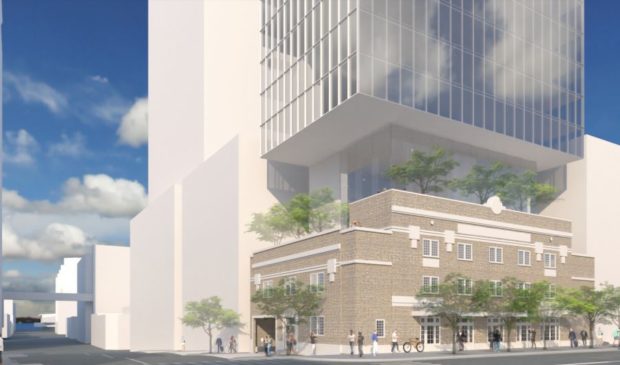Historic Landmark Commission hesitantly approves Masonic lodge renovation plans
Thursday, October 31, 2019 by
Jessi Devenyns After months of discussions and tweaks to the original plans for the Royal Arch Masonic Lodge, the Historic Landmark Commission finally came to a compromise with designers for a 30-plus-story addition to the 93-year-old ancestral home of the Masons at 311 W. Seventh St.
In a 6-4 vote, the commissioners approved the initial certificate of appropriateness for the schematic designs presented at their Oct. 28 meeting. Commissioners Terri Myers, Ben Heimsath, Blake Tollett and Kelly Little voted against the motion despite assurances from the developers that they would return periodically for updates and input as they refine the designs and apply for a final certificate of appropriateness for building permits.
“I can’t get around that this tower doesn’t reference the historic resource in any way,” said Commissioner Terri Myers, referring to the Secretary of the Interior’s Standards that govern what designs the commission may allow for additions to a historic structure.
Commissioner Emily Hibbs noted that although she liked the design, the height of the addition was “startling” and that she too believes it prevents the design from meeting the Secretary of the Interior’s Standards.
The height of the glass tower that will jut out of the top of the three-story limestone lodge was at the crux of the division between commissioners who supported the design and those who didn’t.
Emily Little of Clayton and Little Architects, the designers of the building, acknowledged that permitting additional height was the one exceptional consideration that the developers were requesting as part of design approval by the commission.
Commissioner Kevin Koch, who expressed hesitation at last month’s meeting about the design, said that after seeing sightlines from the passersby perspective, “The pedestrian experience with the building will stay largely unchanged.”
Koch explained his reasoning, saying it is unlikely people walking by will have their necks craned toward the sky. Therefore, he said, “The extreme height doesn’t bother me because I don’t think anyone is going to perceive that.”
Commissioner Ben Heimsath disagreed, saying that “walking through and seeing things on a computer are not necessarily the same … All you have to do is look up. If the building is too big, it will be very apparent.”
Kyle Nigro, the building manager for the property, told commissioners that the plans for a skyscraper came out of necessity. The Masonic lodge is in dire need of repairs that could range anywhere from $200,000 to $400,000. He said those kinds of funds are not available without altering the footprint of the building to allow for revenue generation in addition to continuing Masonic activities on-site.
The plans for the lodge include a restaurant and hotel in the 30-plus-story glass tower that would rise up from between the four historic walls of the lodge. Those historic walls, Brett Rhode of Rhode Partners assured commissioners, will remain intact during construction and will be stable for the next 100 years.
“I’m very confident we can do this without removing the exterior masonry,” he said. On the off chance that something unplanned does transpire, “If there were a reason we would need to remove the exterior masonry of the building, we would restore it back to how it is today.”
Even with the historic structure remaining intact, Guy Dudley, president and CEO of Stone Development Group, told commissioners that the Masons, who will retain ownership of the building, will not seek any of the tax benefits that accompany a historical building. Instead, “we are planning on bringing $1.5 million of tax into the city of Austin,” he said. Dudley could not be reached by the Austin Monitor to confirm what building scale these calculations were based on.
Commissioner Tollett expressed his interest in seeing a restrictive covenant on the property that would prevent the owners from seeing a tax break in the future.
Other commissioners voiced their hesitation that the applicant had no legally binding guarantees or bonds to ensure the preservation of the exterior facade. Commissioner Witt Featherston suggested requiring a bond for the integrity of the original structure as part of the commission granting a final certificate of appropriateness for the project.
Commenting on the arduous process of approving the first set of designs, commissioners and staff felt like the slow unfurling of the design process was appropriate, considering the gravity of the impending change.
“We don’t want to set a precedent of building high-rise towers on top of historic landmarks,” said Historic Preservation Officer Steve Sadowsky.
Tollett added that, as the meetings are public, it may give another architect the time to come up with a better design and present it for consideration – if the current one falls through.
Rendering via the city of Austin.
The Austin Monitor’s work is made possible by donations from the community. Though our reporting covers donors from time to time, we are careful to keep business and editorial efforts separate while maintaining transparency. A complete list of donors is available here, and our code of ethics is explained here.
You're a community leader
And we’re honored you look to us for serious, in-depth news. You know a strong community needs local and dedicated watchdog reporting. We’re here for you and that won’t change. Now will you take the powerful next step and support our nonprofit news organization?



